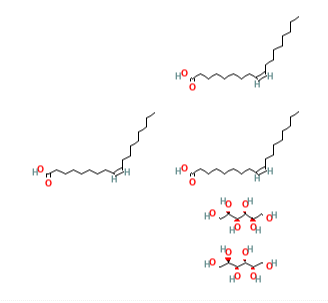Check the ingredients!
... live healthy!


| "Descrizione" by Whiz35 (11828 pt) | 2023-Dec-03 20:39 |
| Evaluation | N. Experts | Evaluation | N. Experts |
|---|---|---|---|
| 1 | 6 | ||
| 2 | 7 | ||
| 3 | 8 | ||
| 4 | 9 | ||
| 5 | 10 |
Sorbitan sesquioleate (SSO) is a chemical compound obtained synthetically by the esterification of sorbitan (dehydrated sorbitol) with fatty acids. The fatty acids used to synthesise sorbitan esters generally include, palmitic acid, lauric acid, oleic acid and stearic acid. The esterification process involves a reaction between an alcohol, in this case sorbitol, and a carboxylic acid, oleic acid, to produce the ester Sorbitan sesquioleate.
It appears as a viscous yellowish liquid that is slightly soluble in ethanol, ethyl acetate, in fatty and mineral oils, petroleum and toluene, and dispersible in water. Insoluble in cold and hot water.

What it is used for and where
Cosmetics
Sorbitan esters are non-ionic lipophilic surfactants that are commonly used as emulsifiers and stabilisers in the formulation of cosmetic creams.
Surfactant - Emulsifying agent. Emulsions are thermodynamically unstable and are used to soothe or soften the skin and emulsify, so they need a specific, stabilising ingredient. This ingredient forms a film, lowers the surface tension and makes two immiscible liquids miscible. A very important factor affecting the stability of the emulsion is the amount of the emulsifying agent. Emulsifiers have the property of reducing the oil/water or water/oil interfacial tension, improving the stability of the emulsion and also directly influencing the stability, sensory properties and surface tension of sunscreens by modulating the filmometric performance.
Emulsifier in water/oil solutions with a value of 3.7 HLB. Generally, the hydrophilic-lipophilic balance (HLB) range is between 1.6 - 8.6, which makes them dissolvable in polar organic solvents and oils.
Food
Sorbitan sesquioleate functions as an emulsifier in food products. Emulsifiers have the property of directly influencing the stability, sensory properties and surface tension of sunscreens by modulating their filmometric performance.
Other Uses
Co-solvent and anti-rust agent for petroleum and oil.
Applications
Safety
Sorbitan sesquioleate has a modest allergy index. A study by the Cosmetic Ingredient Review Expert panel was credited with an allergy rate of less than 1% (1).
Typical commercial product characteristics Sorbitan sesquioleate
| Appearance | Viscous Liquid Pale Yellow or Brown |
| Boiling Point | 738.7ºC at 760 mmHg |
| Flash Point | 205.1ºC |
| Density | 0.993g/cm3 0.989 g/mL at 25 °C(lit.) |
| PSA | 292.20000 |
| LogP | 13.24590 |
| Refraction Index | 1.493 |
| Vapor Pressure | 0.81 psi ( 20 °C) |
| Acid value | 8.5 mgKOH/g |
| Hydroxyl value | 188 mgKOH/g |
| Saponification Value | 149 mgKOH/g |
| Water Content | ≤ 1 % |
| Viscosity | 1500 mPa.s |



Synonyms
References______________________________________________________________________
(1) Lanigan RS, Yamarik TA; Cosmetic Ingredient Review Expert panel. Final report on the safety assessment of sorbitan caprylate, sorbitan cocoate, sorbitan diisostearate, sorbitan dioleate, sorbitan distearate, sorbitan isostearate, sorbitan olivate, sorbitan sesquiisostearate, sorbitan sesquistearate, and sorbitan triisostearate. Int J Toxicol. 2002;21 Suppl 1:93-112. doi: 10.1080/10915810290096414.
Abstract. Sorbitan fatty acid esters are mono-, di-, and triesters of fatty acids and sorbitol-derived hexitol anhydrides. They function as surfactants in cosmetic formulations. Previously, the Cosmetic Ingredient Review (CIR) Expert Panel had reviewed the safety of several of these sorbitan fatty acid esters (Sorbitan Laurate, Sorbitan Oleate, Sorbitan Palmitate, Sorbitan Sesquioleate, Sorbitan Stearate, Sorbitan Trioleate, and Sorbitan Tristearate). This safety assessment is an addendum to that report that includes Sorbitan Caprylate, Sorbitan Cocoate, Sorbitan Diisostearate, Sorbitan Dioleate, Sorbitan Distearate, Sorbitan Isostearate, Sorbitan Olivate, Sorbitan Sesquiisostearate, Sorbitan Sesquistearate, and Sorbitan Triisostearate. Although concentrations of these ingredients up to 25% have been reported to be used, most commonly they are used at less than 10%. These esters may be hydrolyzed to the fatty acid and anhydrides of Sorbitol. Fatty Acids are absorbed and metabolized. Sorbitan fatty acid esters were relatively nontoxic via ingestion in acute and long-term studies. They were generally minimal to mild skin irritants in animal studies, except that Sorbitan Isostearate applied to the skin was a moderate irritant in one rabbit study and when injected intradermally caused mild to severe irritation in guinea pigs. Sorbitan fatty acid esters did not sensitize guinea pigs. The fatty acid component, tested alone, typically caused only slight irritation and sensitization, and was not photosensitizing. Sorbitan fatty acid esters were not ocular irritants. Fatty acids are normal components of diet for which no data were available concerning reproductive or developmental toxicity, but Sorbitol had no adverse effects on the reproduction of CD rats during a multigeneration feeding study and was not a reproductive toxin at doses of 3000 to 7000 mg/kg/day for 2 years. Overall these esters and their corresponding fatty acids were not mutagenic, but Sorbitan Oleate was reported to reduce DNA repair following ultraviolet radiation exposure in human lymphocytes in culture. Sorbitan Laurate and Sorbitan Trioleate were cocarcinogens in one mouse study, but Sorbitan Trioleate and Sorbitan Oleate were not tumor promoters in another study. In clinical tests, Sorbitan fatty acid esters were generally minimal to mild skin irritants and were nonsensitizing, but Sorbitan Sesquioleate did produce an allergic reaction in fewer than 1% of patients with suspected contact dermatitis and addition of Sorbitan Sesquioleate to the components of a fragrance mix used in patch testing increased both irritant and allergic reactions to the fragrance mix. Careful consideration was made of the data on the cocarcinogenesis of Sorbitan Laurate and Sorbitan Trioleate, but the high exposure levels, high frequency of exposure, and absence of a dose-response led to the conclusion that there was not a cocarcinogenesis risk with the use of these ingredients in cosmetic formulations. Accordingly, these ingredients were considered safe for use in cosmetic formulations under the present practices of use.
| Evaluate |